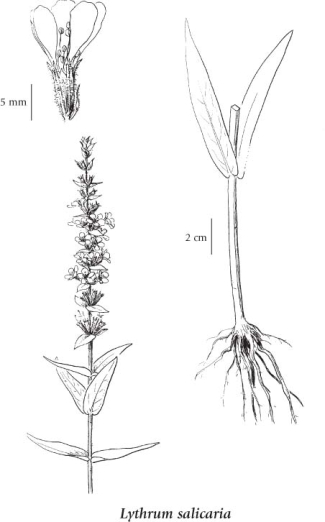purple loosestrife
Lythraceae (Loosestrife family)
Introduction to Vascular Plants
Introduction
Purple loosestrife is a pink or purple flowered perennial wetland species that originates in Eurasia but is now established in North America. It is found in most US states and Canadian provinces (USDA 2010). It has been present in Canada for many decades (a specimen was collected near Quebec City in 1883) (Environment Canada 2007). However, there are no collections for purple loosestrife in the UBC herbarium prior to 1950, so it is a more recent arrival in British Columbia.
Purple loosestrife is a significant invasive species in wetlands. It can reproduce both by seed and vegetative propagation, and one plant can produce millions of seeds. Research has clearly shown that purple loosestrife displaces native wetland species (Gaudet and Keddy 1988, Urbatsch 2000). Biological control has had mixed success, including in British Columbia (Myers 1999). |
Species Information
General:
Perennial herb from a rhizome; stems erect, simple to branched above, 4-angled, 50-200 cm tall.
Leaves:
Basal leaves lacking; stem leaves opposite, or sometimes whorled in 3's or sometimes alternate above, especially the basal ones, lanceolate, 3-10 cm long, pointed at the tips, more or less cordate at the bases, short-hairy to soft-hairy.
Flowers:
Inflorescence of crowded, terminal, but interrupted, bracted spikes; hypanthium elongate-cylindric to conic, purplish, 4-5 mm long; petals 5, 6 or lacking, purple, 7-10 mm long.
Fruits:
Capsules, egg-shaped; seeds egg-shaped.
Illustration

If more than one illustration is available for a species (e.g., separate illustrations were provided for two subspecies) then links to the separate images will be provided below. Note that individual subspecies or varietal illustrations are not always available.
Illustration Source: The Illustrated Flora of British Columbia
Ecology
The table below shows the species-specific information calculated from
original data (BEC database) provided by the BC Ministry of Forests and Range.
(Updated August, 2013)
| Site Information |
Value / Class |
||
|
Avg |
Min |
Max |
|
| Elevation
(metres) |
397 | 397 | 397 |
| Slope
Gradient (%) |
10 | 10 | 10 |
|
Aspect (degrees) |
100 | 100 | 100 |
| Soil
Moisture Regime (SMR) [0 - very xeric; 4 - mesic; 8 - hydric] |
7 | 7 | 7 |
| Modal
Nutrient Regime
Class |
D | ||
| #
of field plots species was recorded in: |
1 | ||
| Modal
BEC Zone Class |
PP | ||
|
All BEC Zones (# of stations/zone) species was recorded in |
PP(1) | ||
|
Source:
Klinkenberg 2013
|
|||
Habitat and Range
Wet meadows, marshes, and ditches in the lowland and steppe zones; frequent on S Vancouver Island and common in the lower Fraser Valley; introduced from Eurasia.Status Information
Synonyms
Synonyms and Alternate Names:
Lythrum salicaria var. gracilior Turcz.
Lythrum salicaria var. tomentosum (Mill.) DC.
Lythrum salicaria var. vulgare DC.
Similar Species
Purple loosestrife is sometimes confused with fireweed (Epilobium angustifolium). Both flower at the same time and are similar in colour. However, purple loosestrife is found only in wetland areas, while fireweed is a dry ground species. Purple loosestrife can also be readily identified by its rigid square stem with opposite leaves.
|
Taxonomic Keys
KEY TO LYTHRUM
1. Hypanthium bell-shaped to hemispheric, petals usually 4, not showy.................Lythrum portula
2. Plants annual, 10-40 cm tall; lower leaves usually alternate; petals 2-3.5 mm long, white to rose...........................Lythrum hyssopifolia Source: Illustrated Flora of British Columbia A fourth species of Lythrum is now recognized in BC: Lythrum alatum (winged loosestrife). This species is not included in the IFBC key, but is described by Hitchcock and Cronquist (1973) as: Main leaves 3-10 cm, not cordate; petals purple, ca 5 mm; plants 4-10 dm. View a photo. |
Taxonomic Notes
Purple loosestrife is the only tristylous plant found growing wild in British Columbia...As in distylous plants, the stamens of different lengths...produce pollen grains of different sizes and in different amounts. In purple loosestrife, there is a difference in the colour of the pollen as well. Pollen from long stamens is green, while pollen from mid-length and short stamens is yellow. The significance of the difference is not known.
Purple loosestrife is the classic example of a tristylous plant and was thoroughly studied by Charles Darwin. Although Darwin is most famous for his theory of evolution by natural selection, he wrote several books on breeding systems and pollination of plants. In his autobiography he wrote that, of his many studies, none had given him as much pleasure as his investigations of the mating systems of heterostylous plants. Source: Extracted with permission from Griffiths and Ganders, 1983. Wildflower Genetics: A Field Guide for British Columbia and the Pacific Northwest. |
References
Griffiths, Anthony J. F. and Fred R. Ganders. 1983. Wildflower Genetics: A field guide for British Columbia and the Pacific Northwester. Flight Press, Vancouver.
Myers, Judith. 1999. Biological Control of Purple Loosestrife in Vancouver, BC. Botanical Electronic News 233 [October 2, 1999]. Available online.